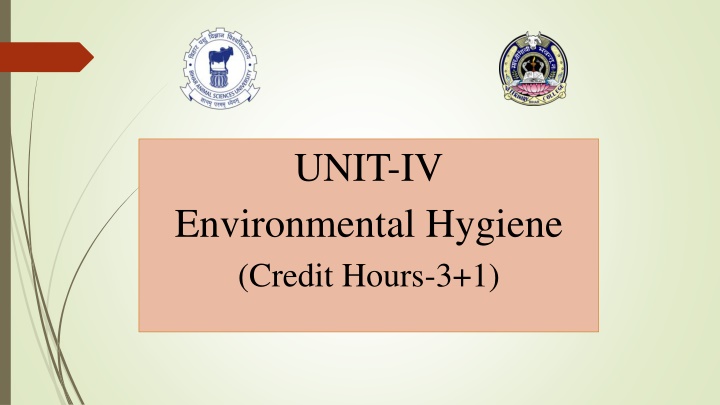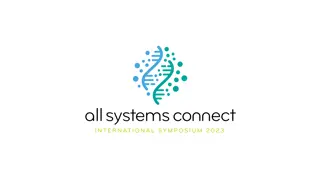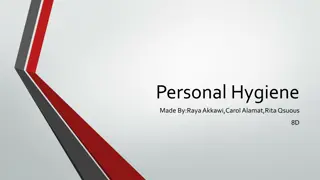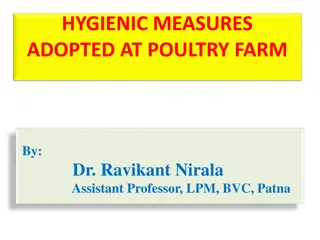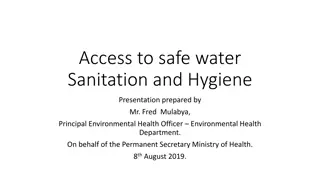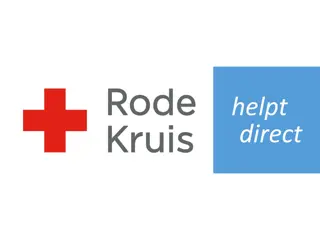Environmental Hygiene and Sanitation in Animal Houses
The science of safeguarding health through environmental sanitation in animal houses encompasses controlling factors that affect physical development, health, and survival. Explore the importance of sanitation, water requirements for animals, and objectives to establish a hygienic atmosphere for livestock, promoting health and productivity while addressing common maintenance problems.
Download Presentation

Please find below an Image/Link to download the presentation.
The content on the website is provided AS IS for your information and personal use only. It may not be sold, licensed, or shared on other websites without obtaining consent from the author.If you encounter any issues during the download, it is possible that the publisher has removed the file from their server.
You are allowed to download the files provided on this website for personal or commercial use, subject to the condition that they are used lawfully. All files are the property of their respective owners.
The content on the website is provided AS IS for your information and personal use only. It may not be sold, licensed, or shared on other websites without obtaining consent from the author.
E N D
Presentation Transcript
UNIT-IV Environmental Hygiene (Credit Hours-3+1)
Introduction The word sanitation means the science of safeguarding health Environmental sanitation: It embraces the control of all those factors in man s (in our context animals) physical environment which exercise a deleterious effect on the physical development (to productivity), health & survival (World Health Organization) The physical environment The non-living objects & physical factors affecting the animals, viz., air, ventilation, lighting, noise, climate & water In fact, the term sanitation covers the whole field of controlling the environment of animals with a view to prevent disease & promote health
Problems in the maintenance of sanitation in animal houses The lack of awareness Poverty Problems of safe water supply Disposal of excreta
Water requirements for animals /animal houses Animal Dairy cows & buffaloes Water requirement 110 lit. water/ cow For maintenance purpose: 28 lit. /d For Milk production: Additional 3 lit. /each lit of milk For washing & cleansing of cow-sheds, animal themselves, utensils an average of another 45-70 lit./cow A horse Under average stable-feeding purposes Washing and other general purpose 36 lit. of water 36 lit. of water Sheep and goats an average daily allowance Pigs For all purposes Hens an avg. 100 hens 18 lit./d/ head 40 lit. /d/head 20-30 lit. /d
Objectives of sanitation 1. To establish hygienic atmosphere & structures 2. To create conditions for comfortable living of livestock (including poultry & ducks) so that they may remain healthy & productive
Requirements of livestock buildings Prime important in maintaining good sanitation Farm livestock are homeotherms: maintain a thermal balance between the heat they produce or gain or loose it from the environment The heat produced & released by the body: working efficiency & production Small amount of heat is lost: excretions & secretions Main heat losses: Radiation, Convection: temperature of air/surrounding, humidity, movement of air Conduction Evaporation
Factors effecting growth and productivity of animals Temperature Regulation at extremes of temperatures Thermo-comfortable zone: optimum production Allow animals to make their own zone: huddling or separation Development of such zones depends: age, sex, species, weight, feeding rate, acclimatization, husbandry system Relative humidity (30 to 90 %): Allows the livestock to thrive well Proper ventilation to maintain ventilation Air movement Air temperature above & below body temperature tend to reduce dissemination of body temperature & compels animals through more exercise, more feed intake & sufferings
Thermo-control in piggeries Pigs regulate the production of heat at some cost in terms of food energy Intensive pig houses: Designed to ensure the best feed conversion efficiency by regulation of temperature & ventilation Optimal efficiency of production increases The optimum temperature range for adult pigs ranges: 4- 300C
Thermo-control in ruminant houses The comfort zone European cattle: 0- 200C Jersey Fresians: 20- 250C, Brown Swiss: 30- 320C Tropical cattle-380C European tropical crossbreds : 300C Management of thermal control: Provision of appropriate sheds, Wallows Artificial shows ameliorate the effect of high temperature In loose housing system: open fronted barns, protection from solar radiation maximum provision of air movement
Large ruminant housing Construction of environmentally controlled house: high standard of thermal insulation of all surfaces round the animals the floor, walls, roof, doors & windows Traditional farm buildings without thermal insulation are common in most organized farms & rural areas Construction of farm buildings primarily to floor, walls & roof Materials for wall construction: Strength, Thermal insulation & Method of construction (in relation to hygiene) The surface should be smooth, impervious with minimum of places allowing dirt accumulation
Large ruminant housing The floor: The animals stand, exercise, move, lie down & excrete It is critical to thermal physical comfort, health & security Should be non-slippery, well drained, Comfortably soft, Warm & dry, Easy to clean mechanically Floors with drainage channel covered with a removable metal grid Design of stalls & mangers: asy consumption of food & less food wastage Edges & crevices: should be avoided wall to floor junctions should facilitate brushing & washing
Large ruminant housing The roof Can be clad with corrugated asbestos or metal sheeting for uniform internal temperature Damp-resistant hard board or flat asbestos sheets can be used as loft seal Bedding: concrete floor with straw or other bedding Reducing heat loss, make it comfortable, Provide desired warmth to milking cow & prevent injuries Clean and dry Soiled portions should be renewed regularly
Large ruminant housing Cleaning of the yard is utmost importance: Slurry & other organic matter should be scrapped properly To prevent foot trouble in animals Dirty ramps tend: become slippery create risk of fall & injury Fly control: Periodic spray of an appropriate repellent in dry shed Wire-netting in the building at a desired height (wall to roof): prevent birds & insects entering & disturbing the animals Lighting arrangement: Particularly during night & early morning hours, Availability of adequate natural light
Calf housing Should be in two units One for very young & another for the older ones It will facilitate disinfection & adequate rest Individual pens with solid partitions are preferred for calves bought from outside so as to prevent the risk of disease Roof lighting: light emitting through a double thickness glass or artificial lighting can be provided
Sheep housing Building with generous air space, i.e., climatic housing Sheep require a cover to protect from elements Sheep fleece provides excellent thermos-insulation Shearing the ewes necessitates good quality housing so as to minimize the risk of suffering from cold & draught Huddling of sheep together in the absence of fleece increases the danger of respiratory and skin diseases in adults and enteric diseased in lambs Adults sheep can withstand in temperature range of 7 to 300C
Poultry housing The problem of sanitation in poultry houses is tackled from different angles, viz., temperature & humidity requirement, Provisions of lighting & watering Temperature: Brooder temperature: 350C (optimum for one day old chicks) reduction of 0.50C daily until a level of 18-210C is reached The change should be steady with reduction uneven air temperatures Broilers house temperature: 18-210C or slightly lower (13 to 160C) would be ideal This can be achieved by increasing ventilation & by use of fans for affecting enhanced air velocity For intensively kept layers, the optimum temperature for productivity and health is about 210C Relative Humidity: Maximum of 75% is acceptable Below 50% (critically if less than 30%): aggravate infections and disseminate contagions
Proper lighting: Development of reproductive organs & egg production A maximum of 18 hours/day of lighting is 49 weeks onwards in case of layers The lighting system with dimming device: provide sufficient & even intensity of light to each bird It can be produced by suspending an ordinary bulb with a reflector at a height of 3 meter at the center of the house The reflector would keep the bulb dust free
